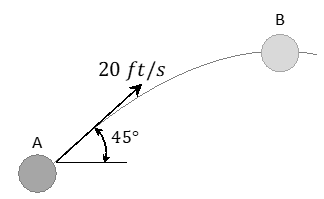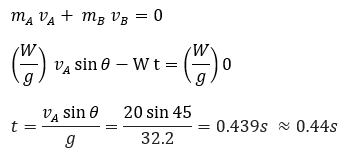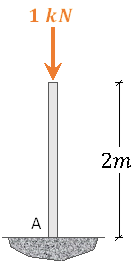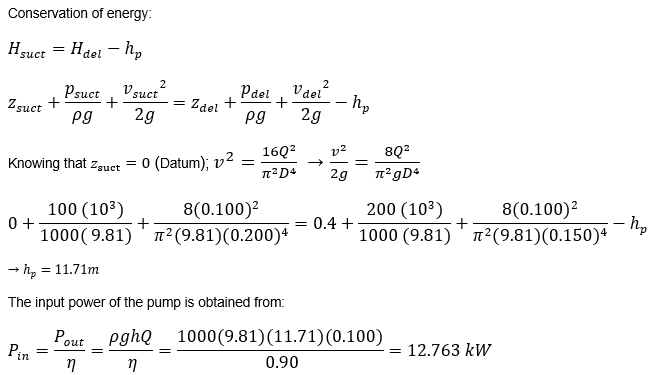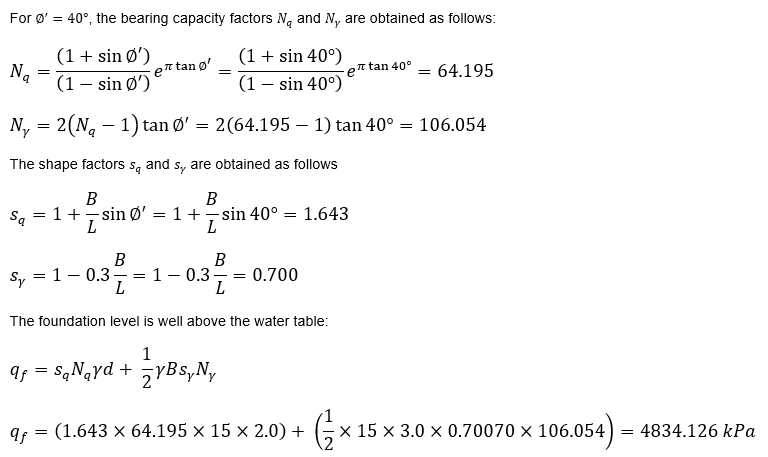Planning to take the NCEES FE Civil Exam? Civil engineering is a rewarding career, but the competition is fierce. Make the most of your civil engineering FE exam by coming in fully prepared for successful results with our FE environmental practice prep.
JobTestPrep’s FE Civil Exam Prep includes the following:
- 220 FE Civil Exams Practice Questions.
- Time - A total of 11 hours of practice.
- Variety - All 14 test subjects are covered.
- Simulated Practice - Each test has a time limit that simulates the conditions you will encounter on the real test.
Click the Get Started Now button and begin practicing.
Each practice test contains detailed answers and explanations
- 220 FE Civil exams practice questions.
- Accurate test-like questions.
- Simulated Practice that mimics the conditions of the real exam.
On this page, you will find free FE Civil practice exam questions and answers along with details about the format, content, and score of the test, Let’s begin.
What are the Fundamentals of the Engineering (FE) Exam?
The FE exam (Fundamentals of Engineering), also known as the EIT exam (Engineer in Training), or the IE exam (Engineering Intern), is the first of two exams engineers must pass for getting a certificate as a professionally licensed engineer (P.E) in the united states.
A typical FE exam is 110 questions and 6 hours long and includes:
- Nondisclosure agreement (2 minutes).
- Tutorial (8 minutes).
- Exam (5 hours and 20 minutes).
- Scheduled break (25 minutes).
The FE is offered for 7 types of specializations:
- Civil.
- Chemical.
- Electrical and Computer.
- Environmental.
- Industrial and Systems.
- Mechanical.
Please note that JobTestPrepPack™ is customized in a way that provides excellent comprehensive practice for every type of FE Civil exam question that may appear on the actual test.
Using our civil engineering FE exam practice resources and study guides will significantly improve your chances of acing the FE Civil Engineering test and securing your place at the top of the application list.
Free FE Civil Exam Practice Questions
Mathematics and Statistics
. Determine the following indefinite integral:
A.
B.
C.
D.
Answer:
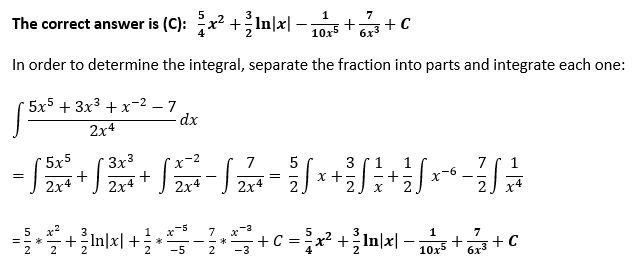
The Mathematics and Statistics section includes the following topics:
- Analytic Geometry.
- Single-Variable Calculus.
- Vector Operations.
- Statistics.
Ethics and Professional Practice
2. One of the responsibilities of the principal contractor in construction projects before commencing with work is to have risk assessments performed. Which one of the following constitutes a risk assessment?
A. Appointment of a full or part-time construction health and safety officer.
B. Plan to mitigate or reduce risks.
C. Appoint a full-time competent employee.
D. Appoint construction supervisors.
Answer:
The correct answer is B.
Risk assessment involves the following activities:
- Identification of risks and hazards.
- Analysis of risks and hazards.
- Plan to mitigate or reduce risks.
- Monitoring plan.
- Review plan.
The Ethics and Professional Section includes the following topics:
- Codes of Ethics (professional and technical societies).
- Professional Liability.
- Licensure.
- Contracts and Contract Law.
Engineering Economics
3. What is the ratio of current assets to current liabilities?
A. Inventory-turnover ratio
B. Curren ratio.
C. Quick ratio.
D. Debt ratio.
Answer:
The correct answer is B.
• The inventory-turnover ratio is the ratio of sales to average inventory balance.
• The current ratio is the ratio of current assets to current liabilities.
• The quick ratio is calculated by deducting inventories from current assets and then dividing the remainder by current liabilities.
• The debt ratio represents the percentage of the total initial investment provided by borrowed funds.
The Engineering Economics Section includes the following topics:
- Time Value of Money.
- Cost.
- Analyses.
- Uncertainty.
Statics
4. The frame in the figure has a mass per unit length of 5 kg/m. What is the y-coordinate of the center of gravity of the structure?
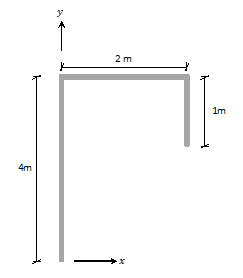
A. 1.214 m.
B. 2.786 m.
C. 3.875 m.
D. 4.000 m.
Answer:
The correct answer is B.
Center of gravity and mass always coincide, i.e. integrate over differential mass elements.
Cross section can be split into simple shapes where the centroid is known, thus integration is replaced by summation.
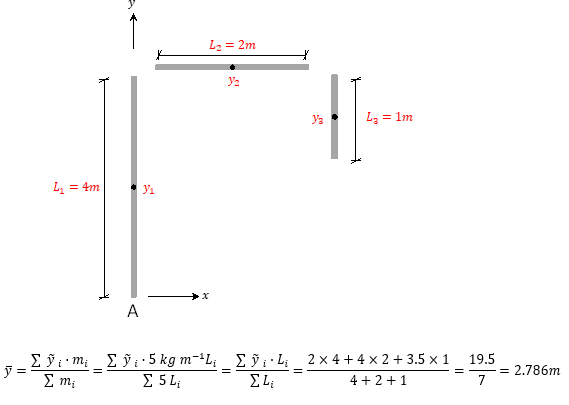
5. How long will it take for a 3 lb ball thrown with a speed vA=20ft/s, as shown in the figure, to reach its highest point B?
A. 0.38s
B. 0.42s
C. 0.44s
D. 0.55s
Answer:
The correct answer is C.
The Statics Section includes the following topics:
- Resultants of Force Systems.
- Equivalent Force Systems.
- Equilibrium of Rigid Bodies.
- Frames and Trusses.
- Centroid of Area.
- Area Moments of Inertia.
- Static Friction.
Mechanics of Materials
6. The 2m long compression member in the figure is fixed on one end and free on the other. What is its effective length?
A. 1.00 m
B. 4.00 m
C. 3.00 m
D. 3.50 m
Answer:
The correct answer is B.
The effective length factor K for a compression member (e.g. column) varies based on the end boundary conditions.
For a member fixed on one end and free on the other, K=2.0.
Therefore, the effective length Leff=L×K=2m × 2.0=4m.
The Mechanics of Materials Section includes the following topics:
- Shear and moment diagrams.
- Stresses and strains.
- Deformations.
- Combined stresses, principal stresses, and Mohr's circle.
Materials
7. Consider the following statements:
1.The most important factor that determines the strength of concrete is the water-cement ratio.
2.Consistency, rate of curing, and durability of asphalt cements are important considerations for their use in pavements.
3.Creep is a high-temperature deformation failure mechanism.
4.During the cement production process, gypsum is added to retard the setting time of cement.
5.Concrete is very strong in tension; however, it is very weak in compression. Reinforcing steel is, therefore, embedded at strategic locations in concrete members to take the compressive stresses.
Which of the following statements is true?
A. 1.
B. 1,2,3.
C. 1,2,3,4.
D. 2,3,4,5.
Answer:
The correct answer is C.
Statements 1)-4) are true.
However, statement 5) is false. Concrete is strong in compression, but weak in tension. Steel on the other hand is strong in tension. Therefore, embedding reinforcement steel at strategic locations enable concrete members to take the tensile stresses.
The MaterialsSection includes the following topics:
- Mix Design of Concrete and Asphalt.
- Test Methods and Specifications of Metals, Concrete, Aggregates, Asphalt, and Wood.
- Physical and Mechanical Properties of Metals, Concrete, Aggregates,
Asphalt, and Wood.
Fluid Mechanics
8. The suction side of the water pump in the figure has a diameter of 200 mm and a pressure gauge reading 100 kPa. On the delivery side, the diameter is 150mm, and the pressure gauge, which is 400mm above the gauge of the suction side, reads 200 kPa. The pump has a flow rate of 100 l/s and the pump efficiency is 90%.
Ignoring minor losses, what is the input power of the pump?
A. 11.2 kW.
B. 11.27 kW.
C. 12.18 kW.
D. 12.76 kW.
Answer:
The correct answer is D.
The Fluid Mechanics Section includes the following topics:
- Flow Measurement.
- Fluid Properties.
- Fluid Statics.
- Energy, Impulse, and Momentum of Fluids.
Surveying
9. A steel band of nominal length 50 m was found to be 50.007 m on standardization. If the steel band measured a distance of 150.120 m, what would be the correct measured distance?
A. 150.121 m.
B. 150.135 m.
C. 149.137 m.
D. 150.141 m.
Answer:
The correct answer is D.
The Surveying Section includes the following topics:
- Angles, distances, and trigonometry.
- Area computations.
- Earthwork and volume computations.
- Coordinate systems.
- Leveling.
Water Resources and Environmental Engineering
10. What is the objective of the secondary wastewater treatment?
A. Removal of Biochemical Oxygen Demand.
B. Control of pesticide runoff.
C. Removal of sand and grit without removing organic material.
D. Removal of solids.
Answer:
The correct answer is A.
The objective of secondary wastewater treatment is to remove Biochemical Oxygen Demand.
The Water Resources and Environmental Engineering Section includes the following topics:
- Basic Hydrology.
- Basic Hydraulics.
- Pumps.
- Water Distribution Systems.
- Flood Control.
- Stormwater.
- Collection Systems.
- Groundwater.
- Water Quality.
- Testing and Standards.
- Water and Wastewater Treatment.
Structural Engineering Design
11. A 3.0 m long rectangular hollow section strut is pinned at its ends, and has the following properties:
Yield stress 400N/mm2, E = 220,000N/mm^2, Iy= 620 cm4, Iz =450 cm4 and A = 19.6 cm2.
If the strut is free to buckle about either the y–y or z–z axes, what is the design compression strength Nb,Rd?
A. 455 kN.
B. 489 kN.
C. 503 kN.
D. 625 kN.
Answer:
The correct answer is A.
The Structural Engineering Section includes the following topics:
- Analysis of Statically Determinant Beams, Columns, Trusses, and Frames.
- Deflection of Statically Determinant Beams, Trusses, and Frames.
- Column Analysis.
- Structural Determinacy and Stability Analysis of Beams, Trusses, and Frames.
- Elementary Statically Indeterminate Structures.
- Loads, Load Combinations, and Load Paths.
- Design of Steel Components.
- Design of Reinforced Concrete Components.
Geotechnical Engineering
12. A 10 m thick soil layer, which has a unit weight of 15kN/m3 and shear parameters c'=0 and ∅'=40°, contains a square footing of width 3 m located at a depth of 2 m in the layer. If the footing level is well above the water table, what is the soil bearing capacity?
A. 4102 kPa.
B. 4834 kPa.
C. 5608 kPa.
D. 5678 kPa.
Answer:
The correct answer is B.
The Geotechnical Engineering Section includes the following topics:
- Index Properties and Soil Classifications.
- Phase Relations.
- Laboratory and Field Tests.
- Effective Stress.
- Stability of Retaining Structures.
- Shear Strength.
- Bearing Capacity.
- Foundation Types.
- Consolidation and Differential Settlement.
- Slope Stability.
- Soil Stabilization.
Transportation Engineering
13. What is the flow at capacity of the flow-speed relationship:
q=37k - 0.28k²?
A. 757 veh/h.
B. 1005 veh/h.
C. 1103 veh/h.
D. 1222 veh/h.
Answer:
The correct answer is D.
The Transportation Engineering Section includes the following topics:
- Geometric Design.
- Pavement System Design.
- Traffic Capacity and Flow Theory.
- Traffic Control Devices.
- Transportation Planning.
Construction Engineering
14. An excavation equipment has a work-hour productivity of 80 bcy/work-hour, O&O cost of about $75/h and operator costs of $38/h.
If this equipment is used to move 1500 bcy of surface dirt, what would be the unit cost?
A. 1,201$/bcy.
B. 1,334$/bcy.
C. 1,334$/bcy.
D. 1,459$/bcy.
Answer:
The correct answer is D.
The Construction Engineering Section includes the following topics:
- Project administration.
- Construction operations and methods.
- Project controls.
- Construction estimating.
- Interpretation of engineering drawings.
Answer Index
| 1 | 2 | 3 | 4 | 5 |
| C | B | B | B | C |
| 6 | 7 | 8 | 9 | 10 |
| B | C | D | D | A |
| 11 | 12 | 13 | 14 | |
| A | B | D | D |
How to Pass the FE Civil Exam?
The FE Civil Engineering Exam has a fairly high 69% pass rate, among first-time takers who took the test within 12 months of graduating. While the exam is passable, intense and smart study is called for.
Included in our comprehensive PrepPack™
220 FE Civil Exams Practice Questions that will provide a total time of 11 hours of practice.
Accurate Test-Like Questions that include All 14 test subjects of the FE civil exam.
Simulated Practice - Each test has a time limit that simulates the conditions you will encounter on the real test.
FAQs
There are only three types of calculators that are permitted for use throughout the exam. Casio fx-115 and fx-991; HP 33s and HP 35; and TI-30X and TI-36X models.
The test is divided into 14 sections:
- Mathematics and Statistics 8-12 questions.
- Ethics and Professional Practice 4–6 questions.
- Engineering Economics 5–8 questions.
- Statics 8–12.
- Dynamics 4–6
- Mechanics of Materials 7–11.
- Materials 5–8.
- Fluid Mechanics 6–9.
- Surveying 6–9.
- Water Resources and Environmental Engineering 10–15.
- Structural Engineering 10–15.
- Geotechnical Engineering 10–15.
- Transportation Engineering 9–14.
- Construction Engineering 8–12.
Please refer to the following FE Civil exam pdf page for more information about the exam's content
All examinees receive a diagnostic report. The purpose of this report is to provide general information on the performance of the examinee. A scaled score from 0 to 15 is provided for each knowledge area, along with the number of items in each.
According to the NCEE website, the pass rate of the FE Civil Exam is 62% of all participants.
The role of civil engineers is to design our living environment. The work they do includes the planning, designing, and overseeing of the construction and maintenance of all types of modern-day infrastructures, such as roads, railways, airports, and bridges.
JobTestPrep is a leading test prep company that offers accurate practice simulations for hundreds of pre-employment tests. Since 1992, it has helped 1M+ candidates. If you have any additional questions about the FE Civil Test, feel free to send us an email, we usually reply within 24 hours.






